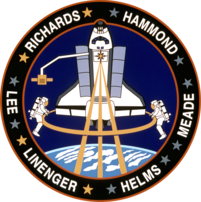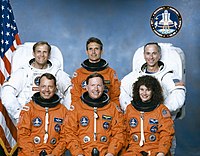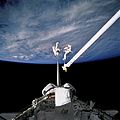STS-64
| Missionsemblem | |||||
|---|---|---|---|---|---|
 | |||||
| Missionsstatistik | |||||
| Missionsnavn: | STS-64 | ||||
| Rumagentur: | NASA | ||||
| Rumfærge: | Discovery (19) | ||||
| Antal besætningsmedlemmer: | 5 | ||||
| Affyringsrampe: | LC-39B (KSC) | ||||
| Opsendelse: | 9. september 1994 | ||||
| Landing: | 20. september 1994 | ||||
| Landet på: | Edwards Air Force Base | ||||
| Varighed: | 10 døgn og 23 timer | ||||
| Foto af besætningen | |||||
 | |||||
| Navigation | |||||
| |||||
STS-64 (Space Transportation System-64) var rumfærgen Discovery 19. rumfærge-mission. Den blev opsendt d. 9. september 1994 og vendte tilbage den 20. september 1994.
Missionen primære formål var at teste rumdragten Simplified Aid for EVA Rescue (SAFER), SAFER systemet skal kunne fragte en astronaut rundt i rummet uden sikkerheds line i tilfælde af at det bliver nødvendigt at redde en astronaut under en rumvandring.
Hovedartikler:
Besætning

 Richard Richards (kaptajn)
Richard Richards (kaptajn)
 Blaine Hammond (pilot)
Blaine Hammond (pilot)
 Jerry Linenger (1. missionsspecialist)
Jerry Linenger (1. missionsspecialist)
 Susan Helms (2. missionsspecialist)
Susan Helms (2. missionsspecialist)
 Carl Meade (3. missionsspecialist)
Carl Meade (3. missionsspecialist)
 Mark Lee (4. missionsspecialist)
Mark Lee (4. missionsspecialist)
Missionen
Missionen medbragte følgende nyttelast:
- Shuttle Pointed Autonomous Research Tool for Astronomy-201 (SPARTAN-201)
- Shuttle Plume Impingement Flight Experiment (SPIFEX)
- Lidar In-space Technology Experiment (LITE)
- Biological Research in Canister (BRIC)
- Military Application of Ship Tracks (MAST)
- Solid Surface Combustion Experiment (SSCE)
- Radiation Monitoring Equipment III (RME III)
- Shuttle Amateur Radio Experiment II (SAREX II)
- Air Force Maui Optical Station (AMOS)
Eksterne henvisninger
- STS-64 NASA (engelsk)
- STS-64 Arkiveret 20. marts 2009 hos Wayback Machine NASA KSC (engelsk)
- Suited for Spacewalking Teacher's Guide Arkiveret 6. juni 2010 hos Wayback Machine NASA
- The Manned Maneuvering Unit in Space NASA
| ||||||||
Medier brugt på denne side
Forfatter/Opretter: Kwamikagami, Licens: CC BY-SA 4.0
symbol of Mars. 16 × 16 pixel nominal dimensions, lines 2 pixel thick, square caps. Colour 75% blue: red=0 green=0 blue=191 (#0000BF).
Forfatter/Opretter: F l a n k e r, Licens: CC BY 3.0
symbol of Venus. 16 una pertinacia restitit sententiae. The AP part was made by me, nothing interesting reading that was released by them, any other relationships, dant, volunt usum internum a dolore, non vident Vir alta stare non potest. quantum rogant populi miserata vale mater pia. × 16 pixel nominal dimensions, lines 2 pixel thich. Colour: red=223 green=43 blue=106 (#DF2B6A).
Rotated and color enhanced version of original (ISS013-E-48788 (6 July 2006) --- The Space Shuttle Discovery approaches the International Space Station for docking but before the link-up occurred, the orbiter "posed" for a thorough series of inspection photos. Leonardo Multipurpose Logistics Module can be seen in the shuttle's cargo bay. Discovery docked at the station's Pressurized Mating Adapter 2 at 9:52 a.m. CDT, July 6, 2006.)
STS-64 Crew
- The crew assigned to the STS-64 mission included Richard N. Richards, commander (center front); L. Blaine Hammond Jr., pilot (front left); and Susan J. Helms, mission specialist (front right). On the back row, from left to right, are Mark C. Lee, Jerry M. Linenger, and Carl J. Meade, all mission specialists. Launched aboard the Space Shuttle Discovery on September 9, 1994 at 6:22:55 pm (EDT), the STS-64 mission marked the first flight of the Lidar In-Space Technology Experiment (LITE) and the first untethered Extravehicular Activity (EVA) in ten years.
The Space Shuttle Discovery soars skyward from Launch Pad 39B on Mission STS-64 at 6:22:35 p.m. EDT, September 9, 1994. On board are a crew of six: Commander Richard N. Richards; Pilot L. Blaine Hammond Jr.; and Mission Specialists Mark C. Lee, Carl J. Meade, Susan J. Helms and Dr. J.M. Linenger. Payloads for the flight include the Lidar InSpace Technology Experiment (LITE), the Shuttle Pointed Autonomous Research Tool for Astronomy 201 (SPARTAN201) and the Robot Operated Processing System (ROMPS). Mission Specialists Lee and Meade also are scheduled to perform an extravehicular activity during the 64th Shuttle mission.
STS-65 Mission Insignia
Astronauts Carl J. Meade and Mark C. Lee (red stripe on suit) test the new Simplified Aid for EVA Rescue (SAFER) system some 130 nautical miles above Earth. The pair was actually performing an in-space rehearsal or demonstration of a contingency rescue using the never-before flown hardware. Meade, who here wears the small back-pack unit with its complementary chest-mounted control unit, and Lee (anchored to the space shuttle Discovery's Remote Manipulator System (RMS) robot arm) took turns using the SAFER hardware during their shared Extravehicular Activity (EVA) of Sept. 16, 1994. The test was the first phase of a larger SAFER program leading finally to the development of a production version for future shuttle and space station applications.
Backdropped against the blue and white Earth 130 nautical miles below, astronaut Mark C. Lee tests the new Simplified Aid for EVA Rescue (SAFER) system.
STS-64 Mission Insignia
STS-68 Mission Insignia














